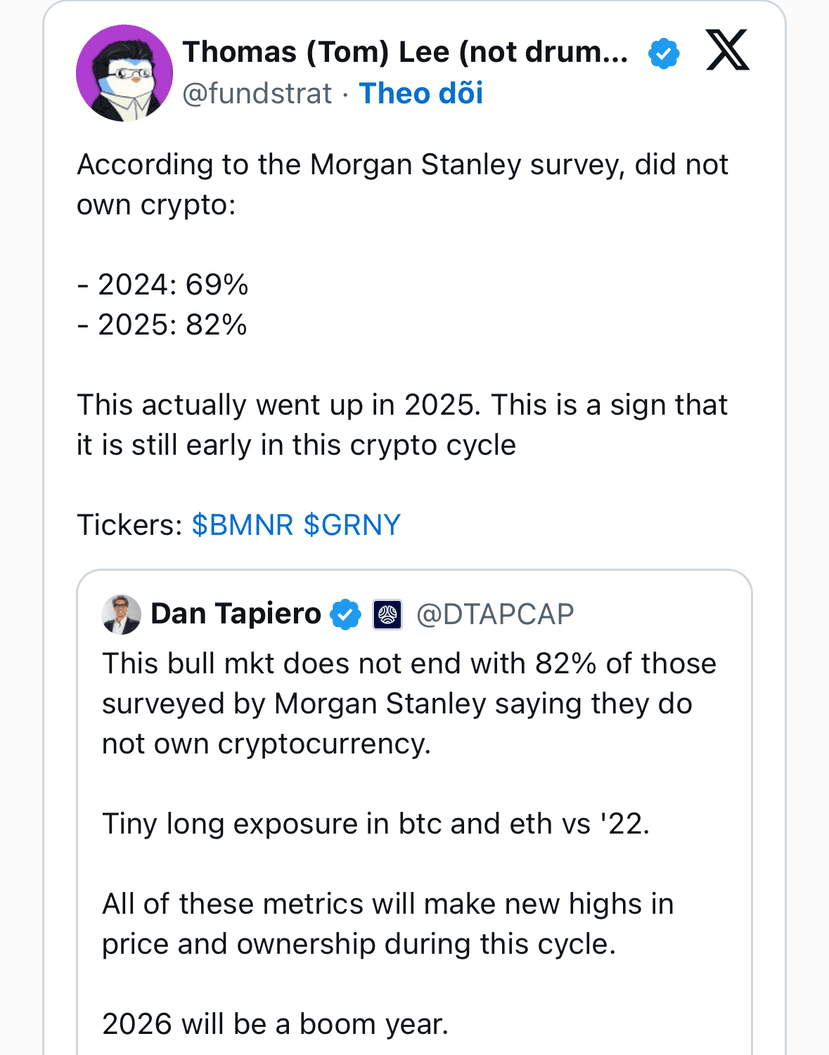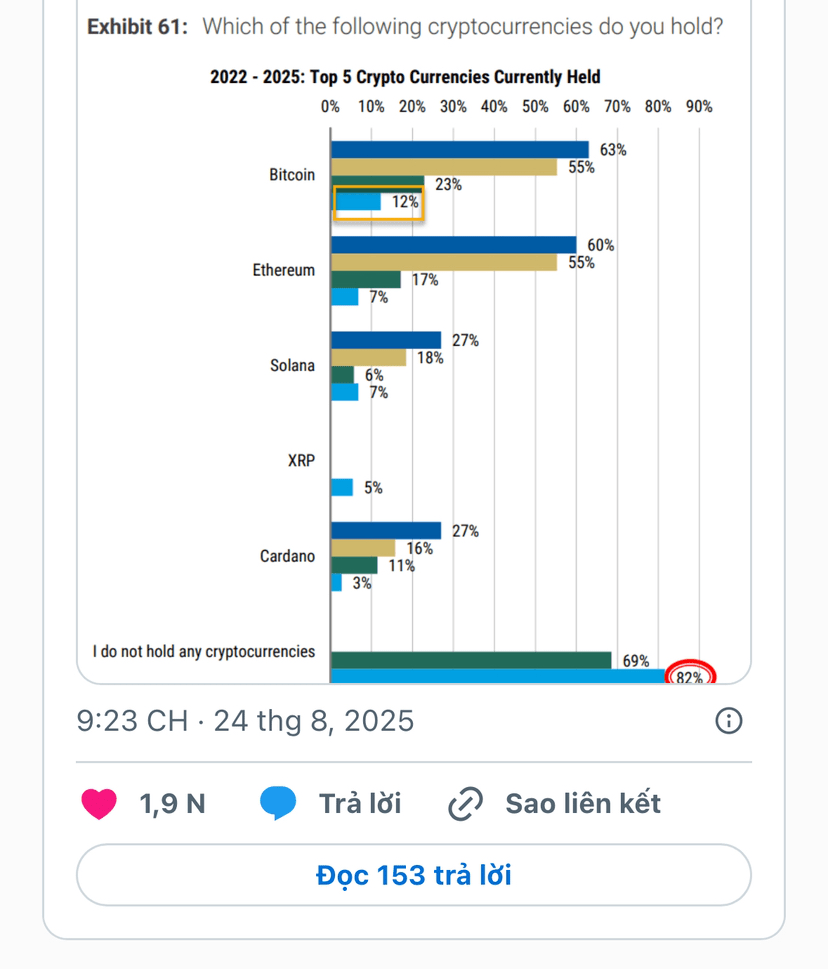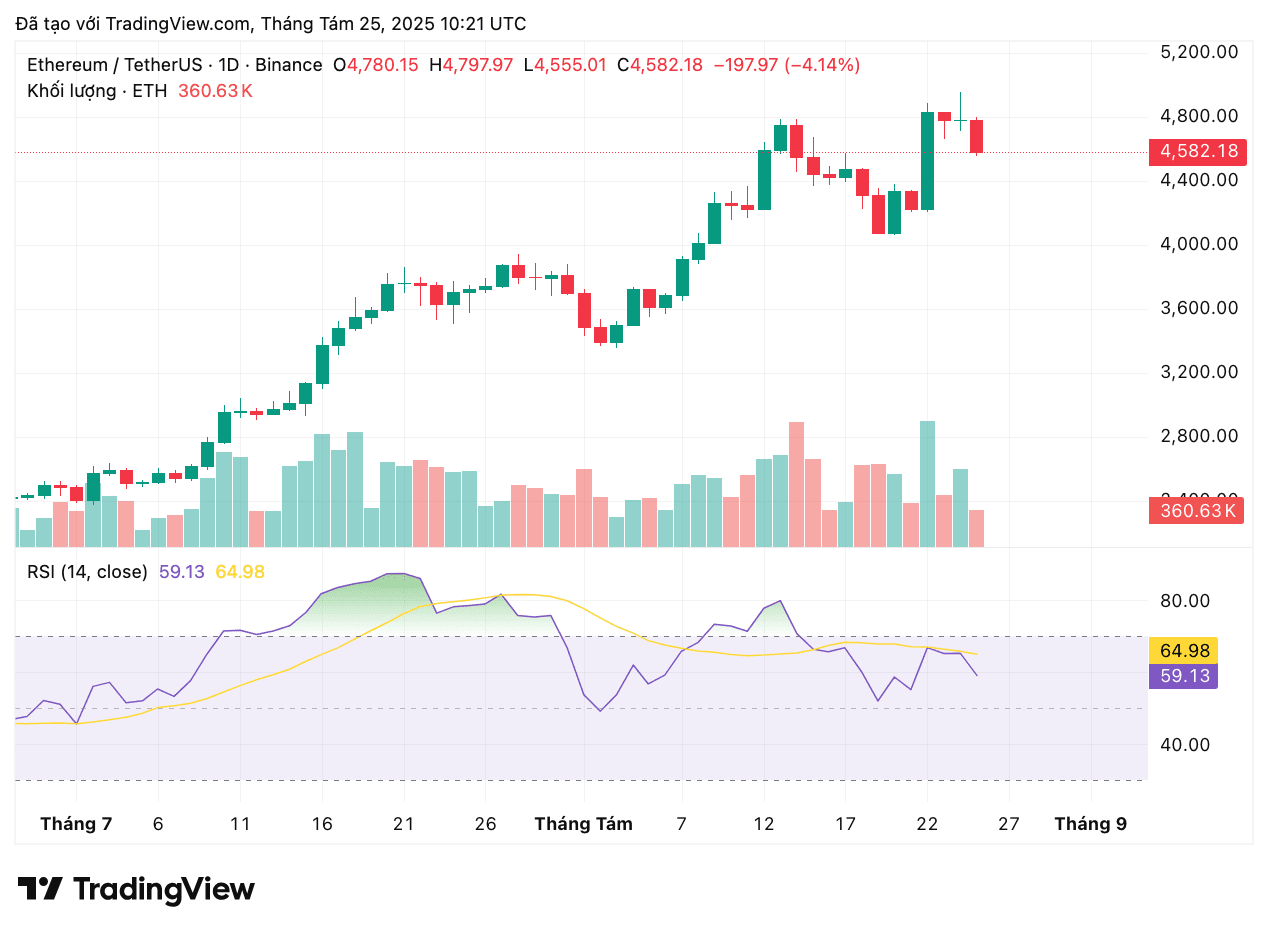Tom Lee – co-founder and Head of Research at Fundstrat Global Advisors – believes that the current cryptocurrency bull market is still in its infancy, despite many major coins having recorded impressive gains recently.
Reason: Traditional finance remains cautious
According to Tom Lee, one of the most important reasons he believes the cryptocurrency bull market is still in its early stages lies in the cautious attitude of traditional finance (TradFi). Despite the digital asset market reaching a market capitalization of trillions of dollars, the participation of banks, investment funds, and large financial institutions remains relatively limited. This means that the market is still primarily driven by individual investors, the tech community, and a few specialized venture capital funds.
Lee argues that until major financial institutions fully ‘invest’, the growth potential of cryptocurrencies remains untapped. Once large banks, pension funds, and global asset management organizations officially consider cryptocurrencies as part of their investment portfolios, a new wave of capital could create strong growth momentum far beyond what the market is witnessing today.


Morgan Stanley – A prime example of hesitation
A clear example of this hesitation comes from Morgan Stanley. Among the bank's interns in Europe, the percentage holding cryptocurrencies has significantly decreased in just two years. In 2022, 63% of interns owned Bitcoin – the largest cryptocurrency by market capitalization. However, this figure has now dropped to just 12%, indicating a rapid decline in interest.
This reflects the general sentiment in traditional finance: instead of viewing cryptocurrencies as a long-term investment channel, many younger individuals are becoming increasingly cautious, possibly due to strong volatility, high-profile collapses (like FTX), or increasingly stringent oversight from regulators.
XRP – A rare exception
However, amid this declining landscape, XRP emerges as an exception. The percentage of Morgan Stanley interns holding XRP has increased from 0% in 2022 to 5% this year. Although this number is still small, it indicates a shift in perception: XRP is gradually being seen as a potentially useful asset due to its role in cross-border payments and Ripple's financial solutions.
The increase in XRP ownership among younger generations working at large banks suggests that, although TradFi remains cautious, some tokens with clear utility are beginning to build trust within the finance community. This could be a sign that the market is not entirely overlooked but is in the process of filtering and repositioning the true value of each digital asset.
Long-term perspective: Forecast for the ‘boom year’ 2026
Tom Lee's perspective shares notable similarities with the predictions of Dan Tapiero – a veteran investor in the digital asset space, who has remarked that 2026 will be the true ‘boom year’ for the crypto market. Tapiero argues that the current cycle is only in the ‘energy accumulation’ phase, while macroeconomic factors, technology, and institutional capital have yet to converge sufficiently to create a climax.
This implies that what investors are witnessing today – although impressive – is just the starting point. A deeper involvement from traditional finance, along with a gradually clearer global regulatory framework, could be the catalyst for a much stronger growth wave in the 2025–2026 period.
Ethereum – The central driver of the bull cycle
Among cryptocurrencies, Ethereum stands out as the ‘leader of altcoins’. Tom Lee has emphasized that ETH has essentially been ‘implicitly’ valued by the market at $6,000, higher than its actual trading level, indicating that its growth potential is still not fully reflected.
According to data from Arkham, the Bitmine company founded by Lee now holds over $7 billion in ETH, becoming one of the largest Ethereum holders in the world. This is not only a sign of strategic confidence but also indicates that large organizations have begun to view ETH as a form of ‘reserve asset’ in their portfolios.
Ethereum recently reached a new historical peak of $4,945. The momentum behind this breakout includes:
A strong influx of Ethereum ETF capital, opening doors for large-scale institutional and individual investors.
The level of application is widening as many global corporations implement Ethereum-based blockchain solutions in payments, supply chain management, decentralized finance (DeFi), and asset tokenization.

From Tom Lee's perspective, the overall picture appears optimistic: the current cryptocurrency market is only in the early stages of a bull cycle, not at its peak. Traditional finance (TradFi) remains cautious, but indicators from ETH and XRP show that interest and confidence are increasing in a selective and focused manner.
If Tapiero's predictions come true, the period of 2025–2026 could witness the convergence of:
A clearer regulatory framework in the US and Europe.
The strong entry of pension funds, banks, and traditional asset management organizations.
Technological momentum from DeFi, tokenization of real assets (RWA), and enterprise applications.
All these factors could propel the market into a new ‘super cycle’ of growth, far beyond the market capitalization and capital flows that investors are currently witnessing.
